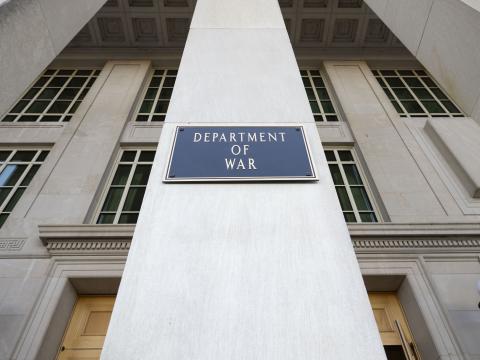Allies Need to Adopt the Courage to Share
The time is now for the United States, NATO and their partner nations to invest resources collectively for truly revolutionary and shared global defense. Partnerships are vital to preempt adversaries and achieve global economic vitality and political stability. This courage to share will enable new levels of success in global security and attainment of national strategic objectives. However, if these nations fail to muster this courage, they will cede advantage and opportunity to adversaries and should not be surprised when those adversaries creatively exploit this to their own benefit.
In today’s increasingly complex defense environment, many nations are struggling to find an affordable approach to deliver military capability to deter and defend against anticipated threats and protect their interests. With a future of austere defense budgets, it is unlikely they will find a viable and expedient solution alone. The United States, NATO nations and their partners no longer can afford to develop new capabilities, technology and hardware independently hoping to maintain an operational advantage over adversaries in a post-Cold War and post-September 11, 2001, world.
Collective defense and more open sharing of sophisticated weapons and information technology developed by partner nations is necessary for the military effectiveness, global economic security and regional stability all nations collectively covet. Opportunity abounds for the United States, NATO and partner nations to increase the sharing of roles, missions, technology and hardware. This will allow them to attain a collective defense effectively by leveraging the unique advantages each nation can provide. Exploiting this opportunity requires courage to execute new relationship paradigms, and these are not without risk. A well-thought approach will minimize these risks and overcome the paralyzing fear of sharing—a fear that exists today and stifles the opportunity to further national interests.
Less expensive, more ubiquitous and increasingly anonymous technology has increased the number of threats significantly. The tremendous growth in these types of technology, especially information technology, forces allied nations to operate and attain superiority in cyberspace along with the more traditional warfighting lines of sea, air, land and space. Achieving and maintaining a military advantage across all domains depends upon leveraging the strengths of each partner nation for the greater good. The greatest challenge in partnering to share technology and capability is to ensure that national interests, particularly potential economic incentives from preeminence in a sophisticated technology or intellectual property, are not put at risk via any co-sharing or multilateral relationships. This requires a common appreciation of the benefits of cooperation by all—finding and sustaining a common interest
While the nature of coalition operations is dynamic and sometimes membership can be ad hoc, a framework of written agreements must be in place to hold nations accountable for their contributions and responsibilities. Other areas of national power—specifically political, economic and industrial—may test those military sharing relationships. Countries competing in markets for economic gain may not want to share technology with a “friendly” competitor because of concerns over a loss of intellectual property that could strengthen an economic competitor. This could result in an unacceptable economic loss, even if that sharing results in a desirable national security advantage for both nations.
With recent economic crises, particularly in the United States, Europe and Asia, it is ineffective for each nation to continue unfettered defense spending to grow redundant military capability when something of similar or better capability is developed by an ally or the commercial marketplace. A more focused approach is for a coalition to designate each nation as the lead on specific capabilities or operational concepts and share that with the other partners for mutual benefit. The nation assigned a specific focus area would be responsible for the leadership role in bringing an operational capability to the coalition and committed to applying its resources to remain at the leading edge in that area.
As each nation contributes to specific specialties, they also would benefit from leveraging the work of other nations leading the development of different capabilities. The result would be a sophisticated, wide-ranging arsenal of capabilities to support all contributing nations, thus increasing the aggregate military capability. In maritime, for example, some nations have developed a higher level competency and technological capability in mine neutralization or mine clearance, opposed boarding of vessels, improvised explosive devices detection, autonomous vehicles, electro-optic sensing, underwater detection in the littoral, diving and salvage, or high speed seaborne logistics. Another good example is NATO’s Cooperative Cyber Defence Centre of Excellence being established in Estonia to leverage the lessons of the unprecedented 2007 cyber assault.
Emerging capabilities present opportunities for nations without resources to become peer providers of traditional warfighting platforms. The cyber domain presents a less expensive option for countries with more limited national defense resources. Instead of building a ship, they could provide advanced cyber attack, prevention or detection capabilities. Cyber dependencies could become a potential Achilles heel for a coalition if cyber vulnerabilities and solutions are not shared, particularly when using common networks. Interdependencies on Internet-based technologies are prevalent, and mutual cooperation in cyberspace is a center of gravity issue for the United States, NATO and its partners.
National sensitivities and protection of technology-sharing agreements must remain at the forefront to avoid a breakdown of trust within a coalition. It certainly is no small task, given the number of organizations involved in these relationships, to include defense contractors with profit motivation. Relationships must be carefully cultivated and managed to maintain trust and commitment. A good practice to build and maintain that trust is to embed coalition liaisons and to establish coordination centers to cultivate relationships and reduce misunderstanding among partners.
Along with new technology, such as the use of unmanned and autonomous vehicles, comes adaptation of operations, requiring critical thought on how it will change the calculus of the fight and revise doctrine, tactics, techniques, procedures and training on those advancements. Game-changing technology can alter command and control (C2) structures and how forces currently manage the battlespace. Enemies also can realize these benefits, and coalition doctrine needs to account for this to neutralize an enemy’s military advantage.
Doctrinal, organizational and training aspects of operational employment of any new advancement must be synchronized with partners. Proficiency cannot be bought but must be gained through frequent participation in exercises and operations, senior leader education and doctrine development. With the employment of revolutionary information systems, it is easy to overlook the need to work out and practice common procedures for C2, shared situational awareness and information sharing.
Overcoming institutional inertia and resistance to sharing are primary factors in the success of any framework for coalition partnering, particularly with intellectual property that may give a nation a strategic or economic leg up.
There are policy and technical challenges to address in tandem. Policy needs to be in place with agreements among nations on what information and technology will be shared and to what extent. All participants must recognize that sharing information and technology is in their national self interest. The established framework should address a sensible way to share information, structured with automated information release mechanisms supported by tear-line policies and metadata tagging. Success in this can be measured by the evidence of sharing in policies, standards for policy interpretation, concepts of military planning and operations, and risk assessments.
Bilateral and multinational agreements will establish how allies share technology and information. While the tendency is to focus on technology, trust is built and maintained through relationships, not systems. Long-standing alliances such as NATO can be used as vehicles for improving military relations and fostering new symbiotic technology, information and role-sharing relationships.
Interpersonal relationships among leaders in the military, academia, industry and research and development communities of the countries involved are vital. On the military side, embedded liaison officers can help bridge gaps and seams that may emerge because of cultural misunderstandings or doctrinal misalignments. Investments in relationships and information exchange must be made across all levels from operations to research to maximize mutual benefit.
Partner nations must accept more risk in information sharing in light of the exigency of obtaining critical operational information, particularly in the cyber domain. Legacy laws, doctrine, policies and systems used for classifying and releasing information to partners must be re-examined for their continued efficacy, and this must openly weigh the true risks and benefits of sharing information. The cybersecurity construct for defense cannot be an impediment and derail sharing that otherwise could achieve significant operational objectives.
Successful burden sharing depends on a uniformly recognized appreciation of the strengths each partner brings to the fight and their opportunities and constraints for sharing. As countries take the lead in areas where they excel—such as Canada for peacekeeping operations, the United Kingdom for mine detection and clearance, and Australia in high-speed seaborne logistics—their recognized expertise would be employed accordingly and used to train and prepare other partner forces. Common integrated exercises and operations will test, build and sustain proficiency as well as reinforce the lead-follow roles.
An excellent example of this was evidenced by the 2012/2013 International Mine Counter Measures (IMCM) Exercises in the Middle East. Any closure of a strategic international strait will have an immediate global economic impact. By leveraging a common interest, 41 nations contributed to the IMCM mission to deter and neutralize seaborne mine threats. Trust, common understanding and forward-leaning information sharing all were hallmarks of this successful effort.
Acknowledged, yet calculated, risks accepted by one nation to show good faith in the sharing relationships should be reciprocated by other nations. Mistrust will be minimized by open, frank communications and transparency in the transfer of capability, information and technology between partners. These relationships will not be without concerns that a shared technology or tactic will be passed to an unintended third party outside the coalition. However, written agreements and sustained transparency in communications will minimize those concerns and avoid missteps that could break relationships irrevocably.
Technology can assist in sharing information more efficiently and securely. A framework for information built on open standards, not products, is ideal to be inclusive of each nation’s contributions. Advances in cloud computing, data tagging, data management and discovery, and mobile computing are revolutionizing industry and can do the same for warfighting. Countries are investing in technology and systems to improve information use and business process efficiency. Military forces could reap those benefits by applying the same methodologies to warfighting processes.
In a shared military coalition environment, the focus should be on open standards data, not systems—authoritative data that could be obtained and used based on proper tags and identity management to control access. Participating nations must agree on the common set of standards, driven by internationally accepted standards bodies such as the World Wide Web Consortium. As industry builds standards-compliant products, countries will bring their own aligned systems and technology to the fight. Any approach also must include common processes for using emerging technology. Partners should use mutually trusted supply chains for systems processing shared data to instill confidence in the data reliability and security for operational decision making.
Cyber protection and defense of systems and data are essential to maintaining high confidence. Collectively agreed upon rules of engagement for data breaches, information loss, infiltration, sharing information about cyber attacks or anomalous indicators of potential cyber attacks and collateral damage should be defined and updated regularly. This includes breaches where data is shared intentionally or inadvertently with a third party not in the partnership but with whom a specific country may have a separate bilateral agreement and fail to properly protect that data or information. This could result in an undesirable loss of coalition sensitive data or intellectual property rights.
Capt. James H. Mills, USN, is an Information Dominance Corps officer with 23 years of experience in carrier strike group, joint, major staff and other fleet assignments founded on the warfighting disciplines of combat systems, cyber, command and control, and information dominance.
Capt. Danelle Barrett, USN, is an Information Dominance Corps officer with 24 years of experience in communications and information operations. She is the commanding officer of Naval Computer and Telecommunications Area Master Station Atlantic.
The opinions expressed by the authors in this viewpoint are theirs and do not necessarily represent those of the U.S. Navy or government.




Comments